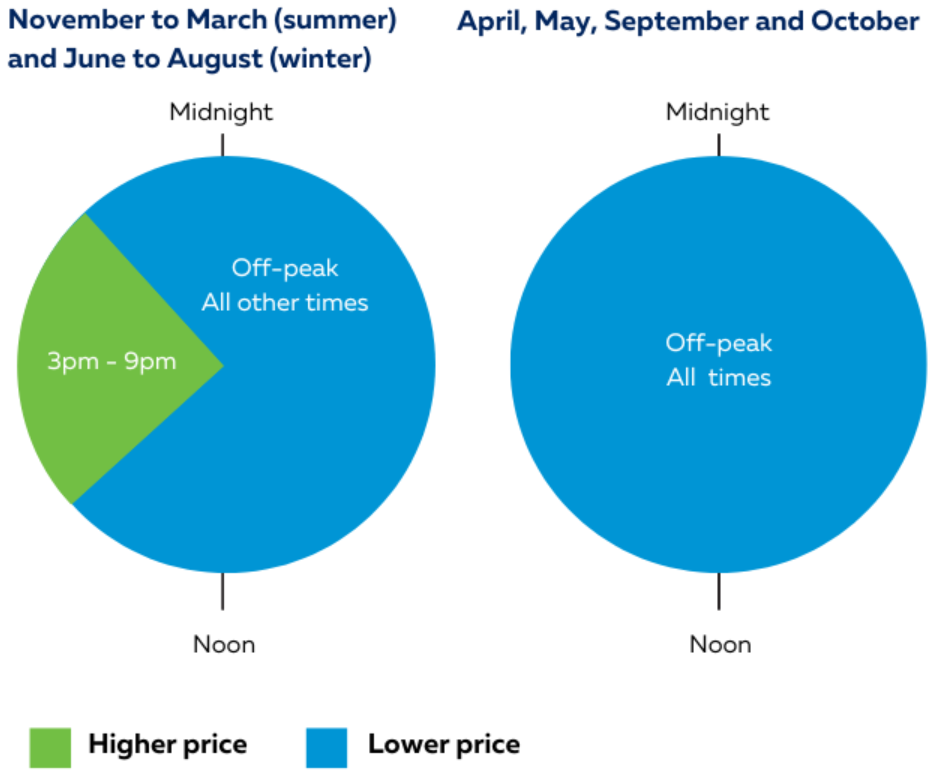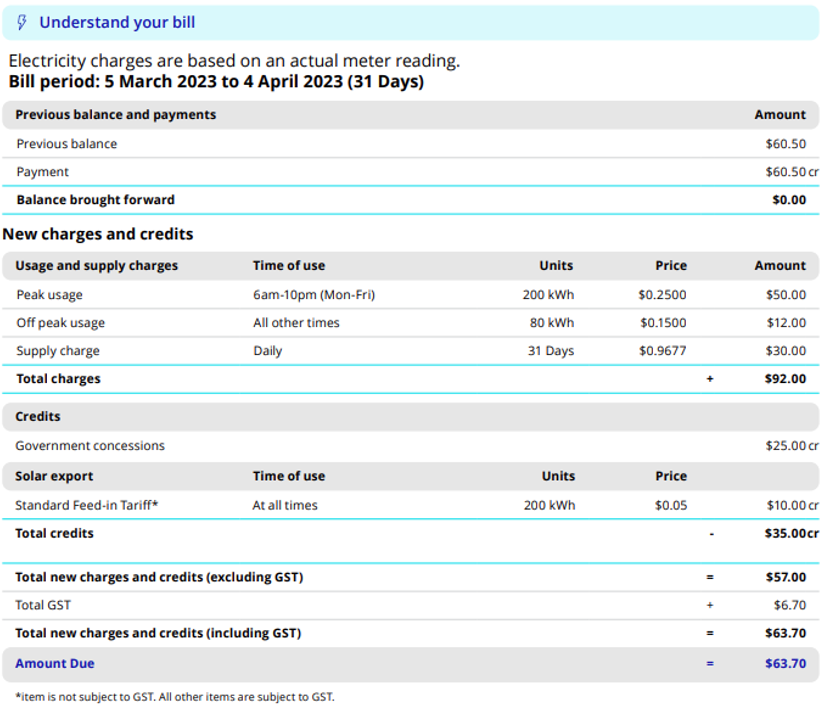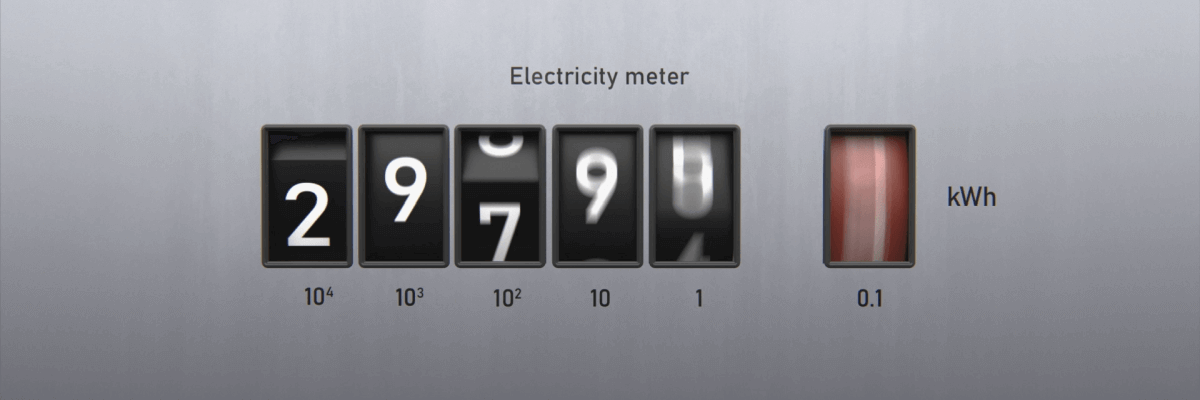KEY POINTS
- A time of use tariff charges customers different prices for electricity usage depending on the time of day.
- The time of use tariff is split into peak, off-peak and shoulder periods which reflect high, low and middle demand respectively.
- You must have a smart meter to access usage periods on a time of use tariff.
This Canstar Blue guide discusses time of use tariffs, including peak and off peak times, how this type of tariff compares to others and if it could be the right tariff for you.
On this page:
- What is a time of use tariff?
- What does a time of use tariff look like on your energy bill?
- What are peak and off-peak electricity times?
- Seasonal variations
- Time of use tariff in NSW
- Time of use tariff in VIC
- Time of use tariff in QLD
- Time of use tariff in SA
- Choosing an electricity plan
- What is a smart meter?
- What is the best electricity tariff for me?
- Is a time of use tariff right for me?
What is a time of use tariff?
A time of use tariff charges customers different prices for electricity usage depending on the time of day. The time of use tariff is split into peak, off-peak and shoulder periods which reflect high, low and middle demand, respectively.
- Peak: Most expensive electricity rates during peak demand periods (i.e. weekdays from 3pm to 9pm).
- Off-peak: Least expensive energy rates, usually overnight and on weekends.
- Shoulder: Slightly cheaper rates, typically between peak and off-peak periods.

Based on Ausgrid. General guide only.
You must have a smart meter to access peak and off-peak usage periods on a time of use tariff.
Provided you have a smart meter and your electricity retailer offers a time of use tariff, you will still be billed for two different charges: a usage charge and a supply charge. A time of use tariff only applies to the usage charge portion of your energy bill. You should only be on a time of use tariff if you have specifically opted into it.
If your bill indicates you’re on a time of use tariff, but you didn’t opt for that tariff type, you should contact your electricity retailer. A time of use tariff can end up adding to your power bill if it’s needlessly applied.
What does a time of use tariff look like on your energy bill?
Details on time of use rates can be found under the ‘charges and credits’ section of your energy bill. Some electricity retailers may use different terms for their time of use tariffs, such as ‘flexible pricing’.
Below is an example of a sample bill from AGL that shows a time of use tariff. The time periods are listed as peak and off-peak, which have different usage rates.

Source: AGL
What are electricity peak and off-peak times?
The specific peak and off-peak times on a time of use tariff will depend on your energy retailer and which distribution network you live in. You can find your energy provider’s peak and off-peak usage times and charges by reading their energy price fact sheets.
Disclaimer: the figures in this article were published in June 2025 and may be subject to change July 2025.
Seasonal variations
Some providers have seasonal variations to their time of use tariffs, designed to reflect the peak seasonal periods. More information on these seasonal changes should be available on your provider’s website.
For example, customers in the Ausgrid network won’t have peak periods during April, May, September or October due to seasonal variations of energy use.
Time of use tariff in NSW
There are three energy distribution networks in NSW: Ausgrid, Essential Energy and Endeavour Energy. Peak and off-peak electricity times in NSW will vary depending on which network you’re on, as well as which energy retailer you’re with.
AGL
- Peak usage rates: 2pm to 8pm, Mon-Fri.
- Off peak usage rates: 10pm to 7am, all week including weekends and public holidays.
- Shoulder rates: 7am to 2pm and 8pm to 10pm, Mon-Fri | 7am to 10pm, Sat-Sun.
Origin Energy
- Peak usage rates: 2pm to 8pm Mon-Fri.
- Off peak usage rates: all other times.
- Shoulder rates: 7am to 2pm and 8pm to 10pm, Mon-Fri | 7am to 10pm, Sat-Sun and public holidays
EnergyAustralia
- Peak usage rates: 2pm to 8pm, Mon-Fri (summer) | 5pm to 9pm, Mon-Fri (winter).
- Off peak usage rates: 10pm to 7am, everyday (all year).
- Shoulder rates: 7am to 2pm and 8pm to 10pm, Mon-Fri (summer) | 7am to 5pm and 9pm to 10pm, Mon-Fri (winter) | 7am to 10pm, Sat-Sun (all year).
Time of use tariff in VIC
Time of use tariffs in Victoria are otherwise known as the two-period time of use Victorian Default Offer. In addition to price, the peak and off-peak electricity times in Victoria are set as a default for each retailer, on each distribution network in the state.
There are five energy distributors in Victoria: Citipower, Jemena, Powercor, AusNet Services and United Energy.
AGL
- Peak usage rates: 3pm to 9pm, everyday.
- Off peak usage rates: 9pm to 12am, 12am – 3pm, everyday.
Origin Energy
Residential two period time of use
- Peak usage rates: 3pm to 9pm, all week.
- Off peak usage rates: all other times.
Residential five-day time of use
- Peak usage rates: 7am to 11pm, Mon-Fri.
- Off peak usage rates: all other times.
EnergyAustralia
- Peak usage rates: 3pm to 9pm, everyday.
- Off peak usage rates: 9pm to 12am, 12am – 3pm, everyday.
Residents in Victoria also have access to a ‘flexible pricing’ tariff, which offers different pricing and peak and off-peak times to the two-period time of use tariff.
Time of use tariff in QLD
Energex is the only energy distribution network for residential customers in South East Queensland. Peak and off-peak electricity times in QLD will be set by Energex and your energy provider.
Customers in regional QLD are on the Ergon Energy network, which is a regulated market, limiting the energy plans available to compare or switch to.
AGL
- Peak usage rates: 4pm to 9pm, all day.
- Off peak usage rates: 9am to 4pm.
- Shoulder rates: 9pm to 12am, 12am to 9am, everday.
Origin Energy
- Peak usage rates: 4pm to 8pm (AEST), Mon-Fri.
- Off peak usage rates: 10pm to 7am, everyday.
- Shoulder rates: 7am to 4pm and 8pm to 10pm Mon-Fri | 7am to 10pm Sat-Sun.
EnergyAustralia
EnergyAustralia doesn’t currently offer a time of use tariff to its customers in QLD. It does, however, offer a demand tariff for residential customers on the Energex network, which has a peak time from 4pm to 9pm, everyday and including public holidays.
Time of use tariff in SA
In South Australia, SA Power Networks is the only energy distribution network for residential customers. Peak and off-peak electricity times in SA will be set by SA Power Networks and your energy provider.
AGL
- Peak usage rates: 6am to 10am and 3pm to 12am, 12am to 1am, everyday.
- Off peak usage rates: 1am to 6am, everyday.
- Shoulder rates: 10am to 3pm, everyday.
Origin Energy
- Peak usage rates: 6am to 10am and 3pm to 1am, everyday.
- Off peak usage rates: 1am to 6am, everyday.
- Shoulder rates: 10am to 3pm, everyday.
EnergyAustralia
- Peak usage rates: 12am to 1am, 6am to 10am and 3pm to 12am, everyday.
- Off peak usage rates: 1am to 6am, everyday.
- Shoulder rates: 10am to 3pm, everyday.
Choosing an electricity plan
If you are interested in comparing your energy plan with cheap plans on a single rate, you can start by clicking on your state on the Canstar Blue comparison table below.
Here are some of the cheapest published deals from the retailers on our database that include a link to the retailer’s website for further details. These are products from referral partners†. These costs are based on the Ausgrid network in Sydney but prices may vary depending on your circumstances. This comparison assumes general energy usage of 3900kWh/year for a residential customer on a single rate tariff. Please use our comparison tool for a specific comparison in your area. Our database may not cover all deals in your area. As always, check all details of any plan directly with the retailer before making a purchase decision.
Here are some of the cheapest published deals from the retailers on our database that include a link to the retailer’s website for further details. These are products from referral partners†. These costs are based on the Citipower network in Melbourne but prices may vary depending on your circumstances. This comparison assumes general energy usage of 4000kWh/year for a residential customer on a single rate tariff. Please use our comparison tool for a specific comparison in your area. Our database may not cover all deals in your area. As always, check all details of any plan directly with the retailer before making a purchase decision.
Here are some of the cheapest published deals from the retailers on our database that include a link to the retailer’s website for further details. These are products from referral partners†. These costs are based on the Energex network in Brisbane but prices may vary depending on your circumstances. This comparison assumes general energy usage of 4600kWh/year for a residential customer on a single rate tariff. Please use our comparison tool for a specific comparison in your area. Our database may not cover all deals in your area. As always, check all details of any plan directly with the retailer before making a purchase decision.
Here are some of the cheapest published deals from the retailers on our database that include a link to the retailer’s website for further details. These are products from referral partners†. These costs are based on the SA Power network in Adelaide but prices may vary depending on your circumstances. This comparison assumes general energy usage of 4000kWh/year for a residential customer on a single rate tariff. Please use our comparison tool for a specific comparison in your area. Our database may not cover all deals in your area. As always, check all details of any plan directly with the retailer before making a purchase decision.
What is a smart meter?
A smart meter, otherwise known as a digital meter, is a device that helps customers on a time of use tariff monitor their electricity usage.
A smart meter works by recording your electricity usage per kilowatt hour (kWh) up to every 30 minutes, with the information then sent to your energy provider for billing.
Smart meters are essential for flexible pricing (i.e. time of use tariffs, controlled load tariffs) as traditional meters can only record energy use at one rate. They are usually attached to time of use tariffs, allowing customers to capitalise on an array of in-house statistics which help track energy costs.
Smart meters also provide electricity retailers with regular updates of a customer’s electricity usage and unlike traditional meters, don’t require manual meter readings.
Aside from tracking your energy consumption, smart meters can also:
- Allow the electricity supply to be switched on or off remotely.
- Alert the electricity distributor when there is a power outage.
What is the best electricity tariff for me?
Each type of tariff will have an impact on your overall energy costs, so it’s important to research which one is best suited for your specific energy needs. Aside from price, you should also consider all of the features of an energy plan, like discounts and benefit periods, plus sign-up incentives.
Below is a non-exhaustive list of households that may benefit from time of use versus single rate tariffs.
← Mobile/tablet users, scroll sideways to view full table →
| Tariff type | Beneficial for homes |
|---|---|
| Single rate | Without a smart meter |
| Consistent energy use throughout the day | |
| That tend to use more energy during peak evening hours. | |
| Time of use | That want a smart meter |
| That want to track and manage their energy usage | |
| That use lots of energy during off-peak hours. |
Is a time of use tariff right for me?
A time of use tariff can be a viable choice if you are conscious of when and how you use electricity. Given that time of use tariffs give you access to cheaper electricity rates during off peak times, you could decrease your energy bills.
However, it’s worth noting that your tariff is not the only aspect contributing to overall electricity costs. If you’re not an energy-intensive user, cheaper supply charges would play a larger role in helping you save money.
On top of that, if you’ve not compared plans for at least 12 months, you’re more than likely on a standing offer plan. Regardless of what tariff you’re on, standing offers are typically more expensive than a market offer with incentives such as sign-up bonuses.
Make sure to compare plans across multiple retailers in your area, to ensure you’re getting a good rate regardless of the type of tariff you’ve signed up for.
If you’d like to compare your energy plan with the cheapest on the market, click on the Canstar Blue link below.
Original reporting by Jared Mullane
Image Source: Frame stock footage/Shutterstock



Share this article